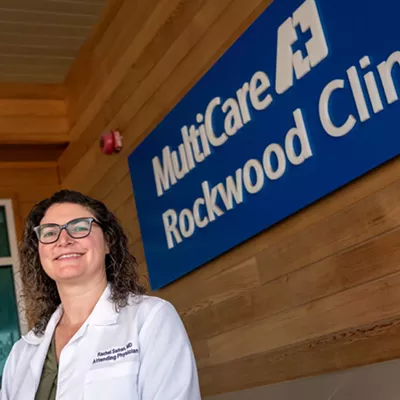Rain starts to patter through the hemlock and cedar. Far off, we can hear thunder. We already have a milk crate full of bagged morels, but my uncle isn't willing to call off the hunt, and neither am I. Not yet. "There's this other place I want to try," he says. "The morels up there are going to be primo." You'd think we were talking about drugs, the way we both raise our eyebrows and nod. My legs are starting to hurt from four hours of thrashing around in the underbrush, and my eyes are buggy from staring too long at moss, fallen logs and pine cones. But at my uncle's words, I perk up. "Really?" Already I'm fidgeting with my jackknife, ready to grab some morels and cut short their already brief fungal lives ...
Mushroom hunting can seem like a lot of work. First you've gotta drive to the mountains. Then you've got to spend a few hours clomping around in the woods for maybe only a handful of small brown mushrooms. And when you get back home, there's still the cleaning. Oh god, the cleaning. In fact, it's not hard to see why even the most desiccated, gnarly specimens still sell for $20-$35 at places like Huckleberry's and at area farmers' markets. But there's also good reason why I -- and dozens of people like me in the Inland Northwest -- set out with plenty of both optimism and Off! year after year. My dad took me out foraging from about the time I could walk and I've never outgrown the excitement of heading into the woods every spring in search of the wily and distinctive morel. Morels (morchella conica) are among the most delicious wild mushrooms you'll ever find, with a delicate nutty flavor and intriguing texture that seems tailor-made for a frying pan, a stick of butter, some kosher salt and a little freshly ground black pepper. In fact, their reputation for being tricky, elusive and impossible to domesticate only seems to add to their worth.
But this has been one of those rare years where the pine cone-shaped fungi have been both plentiful and easy to find. In fact, the second time I went out this spring, I came home with a nearly unmanageable 16 lbs. The season can begin as early as March in the lowlands, but due to the unseasonably cold temperatures, people are still finding patches of new morels in areas that would have "gone by" by now.
"Right now is prime morel season," says Tim Gerlitz of the North Idaho Mycological Association. "This is one of the best morel years we've seen in a long time. And it's been a pretty good year for spring mushrooms in general. When you've got a lot of water percolating through the ground, like we've had with all the rain, and then cooler temperatures combined with a few nice sunny days, you've got a good chance of finding mushrooms."
What's out there -- Here in the Inland Northwest, morels and boletes are two of the more popular and plentiful mushroom varieties. Morels are often a good mushroom for beginners, as they don't mimic the appearance of more poisonous mushrooms. Still, it's important not to confuse a true morel with any of the false ones. Gyromitra gigas and gyromitra esculenta, as the false morels are named, are often listed as edible in earlier mushrooming guides, but later research has shown that the esculenta, in particular, is loaded with a compound that's one molecule away from being rocket fuel. And while they don't look much like a true morel, people do sometimes err on the side of wishful thinking.
"It's a good idea to take a mushroom identification class or go with someone who knows what they're doing," says Lori Carris, of the Palouse Mycological Association. "That way, you can make sure you're not making mistakes. Sometimes beginners will see something that sort of looks like a morel and they'll think it's maybe a mutant form or something. That's where people get into trouble."
As the morel season winds down, the season for boletes is just beginning. Boletus edulis is the Latin name for the delicious porcini mushroom and they usually appear in early summer, typically June or even July. As tasty as they are sauteed fresh, they are often even better dried and used later in Italian cooking.
"Boletus edulis is one of the best-drying mushrooms there is," says Gerlitz. "They have the most concentrated flavor of all the mushrooms when they're dried."
Where to go -- While people often fiercely guard the location of their favorite mushrooming spot, it's not hard to find a few spots of your own once you know what to look for.
"Morels tend to like a disrupted habitat," says Carris. "In particular, they like a burned-over area, like where there's been a forest fire that's overwintered. They also show up a lot where the ground has been disturbed."
In addition to logging sites, forest campgrounds and burn areas, morels have been showing up in some highly unusual places this spring. These "urban morels" have been reported showing up in beauty bark in yards -- my 10-year-old nephew spotted a whole slew of them in his front yard -- in a combination of dirt and gravel just blocks from downtown in Peaceful Valley, in South Hill gardens and even in Riverfront Park.
Clues to when the morel season is in full swing often come from other plants. Up in the woods, I start looking for white trillium and delicate wild orchids, but you can often tell just by looking at the flora closer to home.
"'When the lilacs are blooming in town' is the famous bit of advice you hear most," says Gerlitz. "Usually that's a pretty good sign."
But for boletes, the hunting advice is completely different.
"Unlike morels, boletus edulis comes back in the same spot year after year," he says. "So if you know of a patch, you might want to start visiting it every few weeks. Boletes are prey to not only insects but deer and other animals out in the woods. So you want to start looking for "mush-humps," where the ground or the pine needles are lifted up by the emerging mushroom."
What to bring -- Unlike most other outdoor activities, mushroom foraging is still refreshingly low-tech, and you won't need hundreds of dollars' worth of Gore-Tex, titanium and graphite gear from REI to get started. A jackknife, a wicker basket (mushrooms don't like to be smothered in plastic) and a guidebook are often all that's needed. Don't forget the bug spray, as it's looking like a big year for ticks. It's also always a good idea to go with a buddy, and if you're new at it, you might want to look into going along with one of the local mycology clubs on a group foray. Toward the end of summer, start looking for workshops being offered at NIC and elsewhere on chanterelle identification. Gerlitz will be teaching a class about chanterelles this summer at NIC, and if the fall is anything like this spring, it could be a banner year for the tasty, delicate chanterelle. But whether you come home with bags of mushrooms or empty-handed, the thrill, as they say, lies in the chase.
"It's a great hobby," says Gerlitz, who works as a manager for the state Medicaid program. "I like to look at it as nature's giant Easter egg hunt."
Local Mycology Organizations
North Idaho Mycological Association
Box 722
Post Falls, ID 83877-0722
www.nicon.org/nima
Palouse Mycological Association
625 SE High St.
Pullman, WA 99163-2318
http://mycology.wsu.edu/mushroom
Spokane Mushroom Club, PO Box 2791, Spokane, WA 99220-2791 -- dstad@juno.com
Books -- All That the Rain Promises and More: A Hip Pocket Guide to Western Mushrooms, by David Arora -- Edible Wild Mushrooms of North America: A Field-to-Kitchen Guide, by David W. Fischer, Alan E. Bessette and R. McKenna Brown -- Mushrooms Demystified, by David Arora -- National Audubon Society Field Guide to North American Mushrooms, by Gary A. Lincoff
Publication date: 05/22/03














